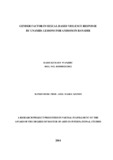| dc.description.abstract | Sexual and Gender Based Violence (SGBV) threatens women and girls, as well as men and boys, in
conflict and post conflict situations globally. Creating strategies for implementation of SGBV
responses and safe environments can only be achieved by addressing gender inequality and
discrimination. This is because armed conflict is a gendered process where women and men
experience it and are vulnerable to its impact in different ways. These are determined by the gender
roles and identities of masculinity and femininity in each individual society. While the scourge of
SGBV is receiving much more attention internationally – as illustrated by United Nations Security
Council Resolutions (UNSC) 1325, 1820, 1888 and 1960 and accompanying resolutions of the
Women, Peace and Security (WPS) Agenda– preventing it is a complex challenge.
In addition, the international community has progressively realized the importance of gender
aspects in peace processes, due to the added value of women’s participation in these processes. The
emerging view is that the inclusion of gender perspectives in the work of peacekeeping has a central
role in the continued credibility for peacekeeping operations, and in the overall achievement of
sustainable peace and security. Achievements by the United Nations (UN) in its peace operations
include appointing women to head operations such as in Cyprus, the institutionalization of gender
mainstreaming with the gender focal points and units at headquarter and field levels; an increase in
the number of female personnel in line with the UN’s system-wide goal of gender balance;
deployment of all-female police units in countries such as Liberia, Haiti and the Democratic
Republic of the Congo; gender training for military, police and civilian peacekeeping personnel;
and incorporation of gender perspectives in planning and programme budgets.
In Africa, with the emergence of the Windhoek Declaration and the Namibia Plan of Action
on Mainstreaming a Gender Perspective in Multidimensional Peace Support Operations in 2000,
there has been a concerted effort to mainstream Gender into PKO. For instance, The African Union
(AU) has policies and instruments that call for gender mainstreaming in peacekeeping operations;
as reflected in the AU’s Constitutive Act; the AU Women and Gender Development Directorate;
the AU’s Gender Policy; the Gender Training Manual for peace support operations; and the opening
of gender offices in the AU-UN Hybrid Operation in Darfur (UNAMID).
However, at AMISOM, there are numerous reports of SGBV being perpetuated by ‘men in
uniform’ which is a case of peacekeepers becoming ‘conflict mongers’ in the bodies of women and
girls. More often than not, these reports are made in private and even if they come out in the public
arena, they are termed as untrue. It is thus imperative that in finding best practices in addressing
SGBV will go a long way in addressing the scourge. This study set out to investigate the degree of
the gaps between policy and implementation, and its significance in contributing to SGBV. To do
so, it critically analysed PKOs responses to SGBV, (which from time to time is used
interchangeably with SBV) in Darfur, Sudan and made policy recommendations that could be
useful for Banadir, Somalia. The study found out that AMISOM has to integrate a protection of
civilian strategy and with it a concerted effort to recruit, train and retain women in both civilian and
military roles. Secondly, incidences of SGBV should be handled with the efficacy that is warranted
and the perpetuators disciplined; thirdly, there is need to have a holistic and multisectoral approach
to implementing SGBV responses, this means working with policy makers, troops contributing
countries, as well as other service providers. Lastly, there should be continuous awareness raising
on machineries available to responses of SGBV for both women and men, girls and boys. | en_US |

